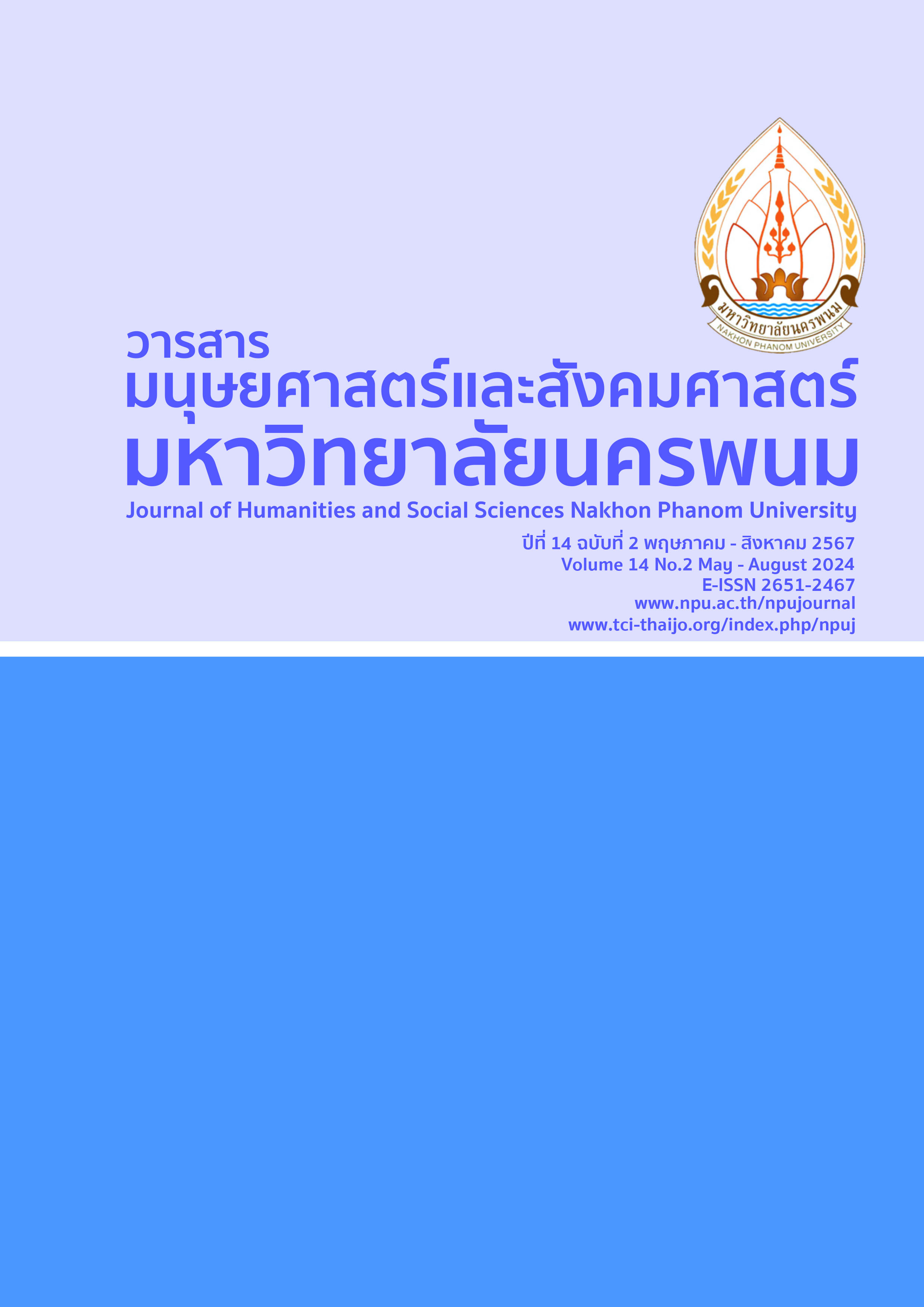การพัฒนากิจกรรมการเรียนรู้โดยใช้ปัญหาเป็นฐาน เพื่อเสริมสร้างความฉลาดรู้ทางการเงินสำหรับนิสิตวิชาชีพครู
Main Article Content
บทคัดย่อ
การวิจัยนี้มีวัตถุประสงค์เพื่อพัฒนากิจกรรมการเรียนรู้โดยใช้ปัญหาเป็นฐาน ที่เสริมสร้างความฉลาดรู้ทางการเงินสำหรับนิสิตวิชาชีพครู และเพื่อศึกษาผลของการใช้กิจกรรมการเรียนรู้โดยใช้ปัญหาเป็นฐาน ที่เสริมสร้างความฉลาดรู้ทางการเงินสำหรับนิสิตวิชาชีพครู วิธีดำเนินการวิจัยใช้การวิจัยแบบผสมผสาน (Mixed Methods Research) รูปแบบเชิงฝังตัวแบบเกิดพร้อมกัน (Concurrent Embedded Design) ที่มีการเก็บรวบรวมข้อมูลเชิงปริมาณและเชิงคุณภาพ กลุ่มเป้าหมาย คือ นิสิตวิชาชีพครู แขนงวิชาสังคมศึกษา วิทยาลัยการศึกษา มหาวิทยาลัยพะเยา ชั้นปีที่ 4 หลักสูตรการศึกษาบัณฑิต ปีการศึกษา 2566 จำนวน 38 คน ซึ่งกลุ่มเป้าหมายนี้ได้มาจากการเลือกแบบเจาะจง (Purposive Sampling) เครื่องมือที่ใช้ในการดำเนินการวิจัย คือ 1) แผนการจัดการเรียนรู้โดยใช้ปัญหาเป็นฐาน จำนวน 6 แผน รวม 16 ชั่วโมง 2) แบบวัดความฉลาดรู้ทางการเงินสำหรับนิสิตวิชาชีพครู จำนวน 50 ข้อ และ 3) แบบสัมภาษณ์แบบมีโครงสร้าง จำนวน 25 ข้อ วิเคราะห์ข้อมูลเชิงปริมาณด้วยสถิติค่าเฉลี่ย ค่าส่วนเบี่ยงเบนมาตรฐาน ร้อยละ และสถิติทดสอบค่าที วิเคราะห์ข้อมูลเชิงคุณภาพโดยการวิเคราะห์เนื้อหา ผลการวิจัย พบว่า 1) ผลการพัฒนากิจกรรมการเรียนรู้โดยใช้ปัญหาเป็นฐาน ประกอบด้วย 6 ขั้นตอน คือ ขั้นที่ 1 เชื่อมโยงและระบุปัญหา ขั้นที่ 2 กำหนดแนวทางในการแก้ปัญหา ขั้นที่ 3 ศึกษาปัญหาขั้นที่ 4 สังเคราะห์ความรู้ ขั้นที่ 5 สรุปและประเมินค่าของคำตอบ และ ขั้นที่ 6 นำเสนอและประเมินผลงาน ซึ่งกิจกรรมการเรียนรู้ที่พัฒนาขึ้นสามารถเสริมสร้างความฉลาดรู้ทางการเงินของนิสิตได้ 2) นิสิตมีความฉลาดรู้ทางการเงินจากการเรียนรู้ด้วยกิจกรรมการเรียนรู้โดยใช้ปัญหาเป็นฐานหลังเรียนสูงกว่าก่อนเรียน อย่างมีนัยสำคัญทางสถิติที่ระดับ .05 และมีความฉลาดรู้ทางการเงิน ด้านความรู้ทางการเงิน ด้านเจตคติทางการเงิน และด้านพฤติกรรมทางการเงิน ในทุกองค์ประกอบหลังเรียนสูงกว่าก่อนเรียน อย่างมีนัยสำคัญทางสถิติที่ระดับ .05 ซึ่งกิจกรรมการเรียนรู้โดยใช้ปัญหาเป็นฐานสามารถพัฒนาความฉลาดรู้ทางการเงินของนิสิตให้สูงขึ้น และกิจกรรมการเรียนรู้โดยใช้ปัญหาเป็นฐานสามารถพัฒนาให้นิสิตส่วนใหญ่มีพฤติกรรม การวางแผนทางการเงินส่วนบุคคลทั้งด้านการจัดการรายได้ การจัดการรายจ่าย การจัดการการออม และการจัดการการลงทุนได้ดี
Article Details

อนุญาตภายใต้เงื่อนไข Creative Commons Attribution-NonCommercial-NoDerivatives 4.0 International License.
เอกสารอ้างอิง
Aujhan, O., Chauvatchrin, N. & Chaturanon, W. (2019). Effects of using problem-based learning management on science subject area of Matthayomsuksa 2 students. Silpakorn Educational Research Journal, 11(2),441-456.
Bank of Thailand. (2021). Report on the survey of financial skills in Thailand 2021. Bangkok : Financial Literacy Promotion Division, Bank of Thailand.
Intaprot, P., Yoonisil, W. & Sinjindawong, S. (2023). The effectiveness of an enrichment of financial literacy curriculum based on brain-based learning management of the undergraduate students in private higher education. Journal of Social Science and Cultural, 7(5),376-390.
Kenan Institute Asia. (2015). Financial Literacy for a Better Life Project 2015. Bangkok : Citi Foundation.
Kraisongkram, P. & Kaoiean, S. (2022). Factors affecting financial literacy among high school students: A multilevel structural equation model analysis. Northeastern University Academic and Research Journal, 12(3),27-40.
Lusardi, A. (2019). Financial literacy and the need for financial education: Evidence and implications. Swiss Journal of Economics and Statistics, 155(1),1-8. doi:10.1186/s41937-019-0027-5
OECD. (2024). Action needed to address gaps in financial literacy among students. Retrieved June 2024, from https://www.oecd.org/en/about/news/press-releases/2024/06/Action-needed-to-address-gaps-in-financial-literacy-among-students.html
OECD INFE. (2011). Measuring financial literacy: Core questionnaire in measuring financial literacy: Questionnaire and guidance notes for conducting an internationally comparable survey of financial literacy. Paris : OECD Publishing.
Office of the Education Council. (2007). Problem-based learning management. Bangkok : Innovation Promotion Group for Teachers and Educational Personnel.
Palatip, P. & Keeratichamroen, W. (2020). A study of learning achievement on law and politics for life learning unit and critical thinking ability of Grade 8 students using problem-based learning with concept mapping. Ratchaphruek Journal, 18(2),74-81.
Piriyarayakul, T., Kamkaet, W. & Phirummsombat, C. (2021). Latent profile analysis of financial behaviors among undergraduate students. Journal of Educational Measurement Mahasarakham University, 27(1),135-152.
Pongchai, Y., Jantakoon, J. & Onthanee, A. (2023). The development of economics learning activities by using online coaching process during COVID-19 crisis to enhance financial literacy for eight grade student. Journal of Roi Kaensarn Academi, 8(2),27-40.
Sakondhawat, K. & Triwaranyu, C. (2020). The development of the economic learning activity package using scenario-based learning to promote the financial literacy of lower secondary school students. Silpakorn Educational Research Journal, 12(2),34-52.
Singhal, M. & Singh, A. (2020). Factors contributing to the financial literacy of individual: A critical literature review. Raja Balwant Singh College, 32(1),1-12.
Suttirat, C. (2009). 80 learning management innovations. Bangkok : Danex Intercorporation.
Sutthipongpan, A. (2020). Personal financial planning behavior of cadets at Chulachomklao Royal Military Academy. Yala Rajabhat University Journal, 16(3),357-366.
Swiecka, B. (2020). Financial literacy: The case of Poland. Sustainability, 12(2),1-17. doi:10.3390/su12020700
Thananivat, C. & Kanjanawasi, S. (2023). Development of a financial literacy assessment for lower secondary school students. Journal of Educational Measurement, Office of Educational and Psychological Testing, 40(107),40-51.
Thai Government. (2023). Summary of the cabinet meeting news. Retrieved October 2023, from https:// www.thaigov.go.th/news/contents/details/73616?fbclid=IwAR2QzDwox0FtShc68OudToMAbuODxQ8OjQK4NcRbrtg7IyPnoOA_aDqlwqY
Thongphuak, P. & Triwaranyu, C. (2019). The effect of teaching economics using simulation games on financial literacy of upper secondary school students. Silpakorn Educational Research Journal, 11(1),348-365.


